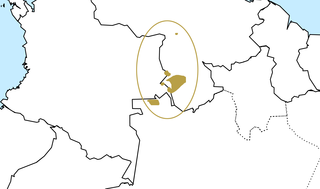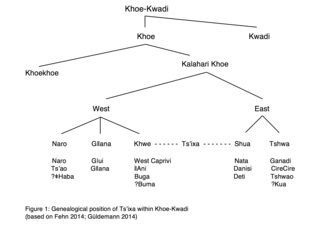
Arawak, also known as Lokono, is an Arawakan language spoken by the Lokono (Arawak) people of South America in eastern Venezuela, Guyana, Suriname, and French Guiana. It is the eponymous language of the Arawakan language family.

Carib or Kari'nja is a Cariban language spoken by the Kalina people (Caribs) of South America. It is spoken by around 7,400 mostly in Brazil, The Guianas, and Venezuela. The language is currently classified as highly endangered.
The applicative voice is a grammatical voice that promotes an oblique argument of a verb to the core object argument. It is generally considered a valency-increasing morpheme. The Applicative is often found in agglutinative languages, such as the Bantu languages and Austronesian languages. Other examples include Nuxalk, Ubykh, and Ainu.

Yanomaman, also as Yanomam, Yanomáman, Yamomámi, and Yanomamana, is a family of languages spoken by about 20,000 Yanomami people in southern Venezuela and northwestern Brazil.
Tariana is an endangered Maipurean language spoken along the Vaupés River in Amazonas, Brazil by approximately 100 people. Another approximately 1,500 people in the upper and middle Vaupés River area identify themselves as ethnic Tariana but do not speak the language fluently.

Arawakan, also known as Maipurean, is a language family that developed among ancient indigenous peoples in South America. Branches migrated to Central America and the Greater Antilles in the Caribbean and the Atlantic, including what is now the Bahamas. Almost all present-day South American countries are known to have been home to speakers of Arawakan languages, the exceptions being Ecuador, Uruguay, and Chile. Maipurean may be related to other language families in a hypothetical Macro-Arawakan stock.
Máku, also spelled Mako, and in the language itself Jukude, is an unclassified language and likely language isolate once spoken on the Brazil–Venezuela border in Roraima along the upper Uraricoera and lower Auari rivers, west of Boa Vista, by the Jukudeitse. 300 years ago, the Jukude territory was between the Padamo and Cunucunuma rivers to the southwest.
Tiriyó is the Cariban language used in everyday life by the Tiriyó people, the majority of whom are monolingual. Although Tiriyó is the preferred spelling, the Tiriyó refer to themselves as tarëno; other variations, including tarano, tirió, and trio, exist. The Tiriyó are located on both sides of the Brazil-Suriname border in Lowland South America. Because Tiriyó is spoken by the entire Tiriyó population, its level of endangerment is low. However, it may be threatened by the presence of a newly installed radar station staffed by a considerable number of non-Indigenous people close to the main village.
Bauré is an endangered Arawakan language spoken by only 40 of the thousand Baure people of the Beni Department of northwest of Magdalena, Bolivia. Some Bible portions have been translated into Bauré. Most speakers have been shifting to Spanish.

Yolmo (Hyolmo) or Helambu Sherpa, is a Tibeto-Burman language of the Hyolmo people of Nepal. Yolmo is spoken predominantly in the Helambu and Melamchi valleys in northern Nuwakot District and northwestern Sindhupalchowk District. Dialects are also spoken by smaller populations in Lamjung District and Ilam District and also in Ramecchap District. It is very similar to Kyirong Tibetan and less similar to Standard Tibetan and Sherpa. There are approximately 10,000 Yolmo speakers, although some dialects have larger populations than others.
Taruma (Taruamá) is a divergent language of northeastern South America. It has been reported to be extinct several times since as far back as 1770, but Eithne Carlin discovered the last three speakers living in Maruranau among the Wapishana, and is documenting the language. The people and language are known as Saluma in Suriname.

Taíno is an extinct Arawakan language that was spoken by the Taíno people of the Caribbean. At the time of Spanish contact, it was the most common language throughout the Caribbean. Classic Taíno was the native language of the Taíno tribes living in the Leeward Islands of the Lesser Antilles, Puerto Rico, the Turks and Caicos Islands, most of Hispaniola, and eastern Cuba. The Ciboney dialect is essentially unattested, but colonial sources suggest it was very similar to Classic Taíno, and was spoken in the westernmost areas of Hispaniola, the Bahamas, Jamaica, and most of Cuba.

Karu, one of several languages called Baniwa (Baniva), or in older sources Itayaine (Iyaine), is an Arawakan language spoken in Guainía, Colombia, Venezuela, and Amazonas, Brazil. It forms a subgroup with the Tariana, Piapoco, Resígaro and Guarequena languages. There are 10,000 speakers.
Paresi is an Arawakan language spoken in Brazil. There are approximately 2000 Paresi people, and around 1800 speak the language. The Paresi live in the state of Mato Grosso, more specifically in nine indigenous territories: Rio Formoso, Utiariti, Estação Parecis, Estivadinho, Pareci, Juininha, Figueira, Ponte de Pedra, and Uirapuru. In terms of endangerment, it is not in immediate danger. It is used in many everyday domains, but there is a lack of transmission to younger generations, as well as an evident language shift to Portuguese. This is a result of Portuguese being used in education and healthcare, as well as the integration of Brazilian culture among the Paresi people, creating changes in their language and cultural practices.
Wapishana (Wapixana) is an Arawakan language of Guyana and Brazil. It is spoken by over 13,000 people on both sides of the Guyana-Brazil border.

Piapoco is an Arawakan language of Colombia and Venezuela.
Yawalapiti (Jaulapiti) is an Arawakan language of Brazil. The Agavotaguerra (Agavotoqueng) reportedly spoke the same language. Speakers of the language live in a village along the edge of the river Tuatuari, a tributary of the Kuluene River, located in the southern part of the Xingu Indigenous Park, in the state of Mato Grosso.

The indigenous languages of the Americas form various linguistic areas or Sprachbunds that share various common (areal) traits. The following list of linguistic areas is primarily based on Campbell.

Tsʼixa is a critically endangered African language that belongs to the Kalahari Khoe branch of the Khoe-Kwadi language family. The Tsʼixa speech community consists of approximately 200 speakers who live in Botswana on the eastern edge of the Okavango Delta, in the small village of Mababe. They are a foraging society that consists of the ethnically diverse groups commonly subsumed under the names "San", "Bushmen" or "Basarwa". The most common term of self-reference within the community is Xuukhoe or 'people left behind', a rather broad ethnonym roughly equaling San, which is also used by Khwe-speakers in Botswana. Although the affiliation of Tsʼixa within the Khalari Khoe branch, as well as the genetic classification of the Khoisan languages in general, is still unclear, the Khoisan language scholar Tom Güldemann posits in a 2014 article the following genealogical relationships within Khoe-Kwadi, and argues for the status of Tsʼixa as a language in its own right. The language tree to the right presents a possible classification of Tsʼixa within Khoe-Kwadi:
The Pidjanan languages are a subgroup of Arawakan languages of northern South America.









